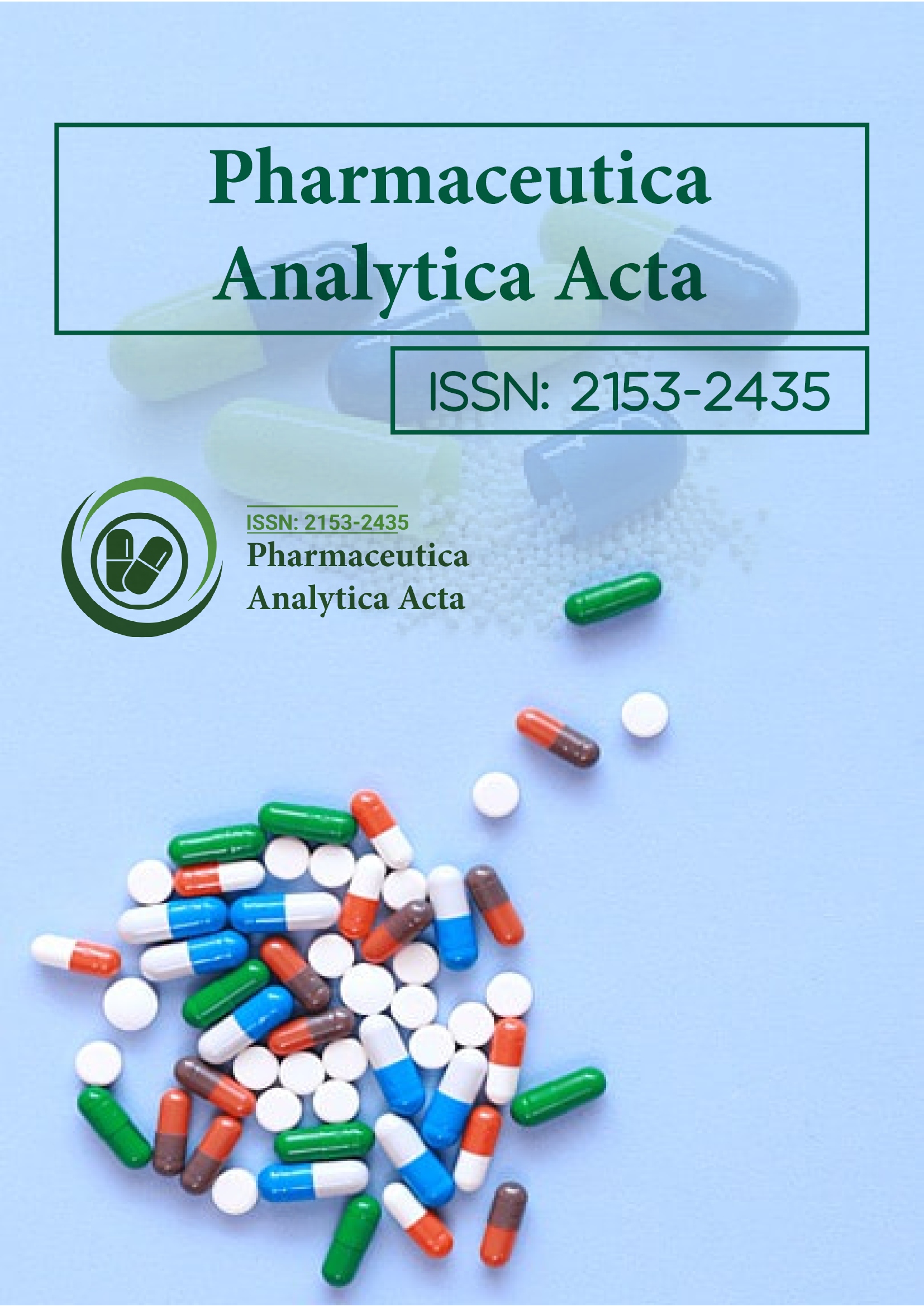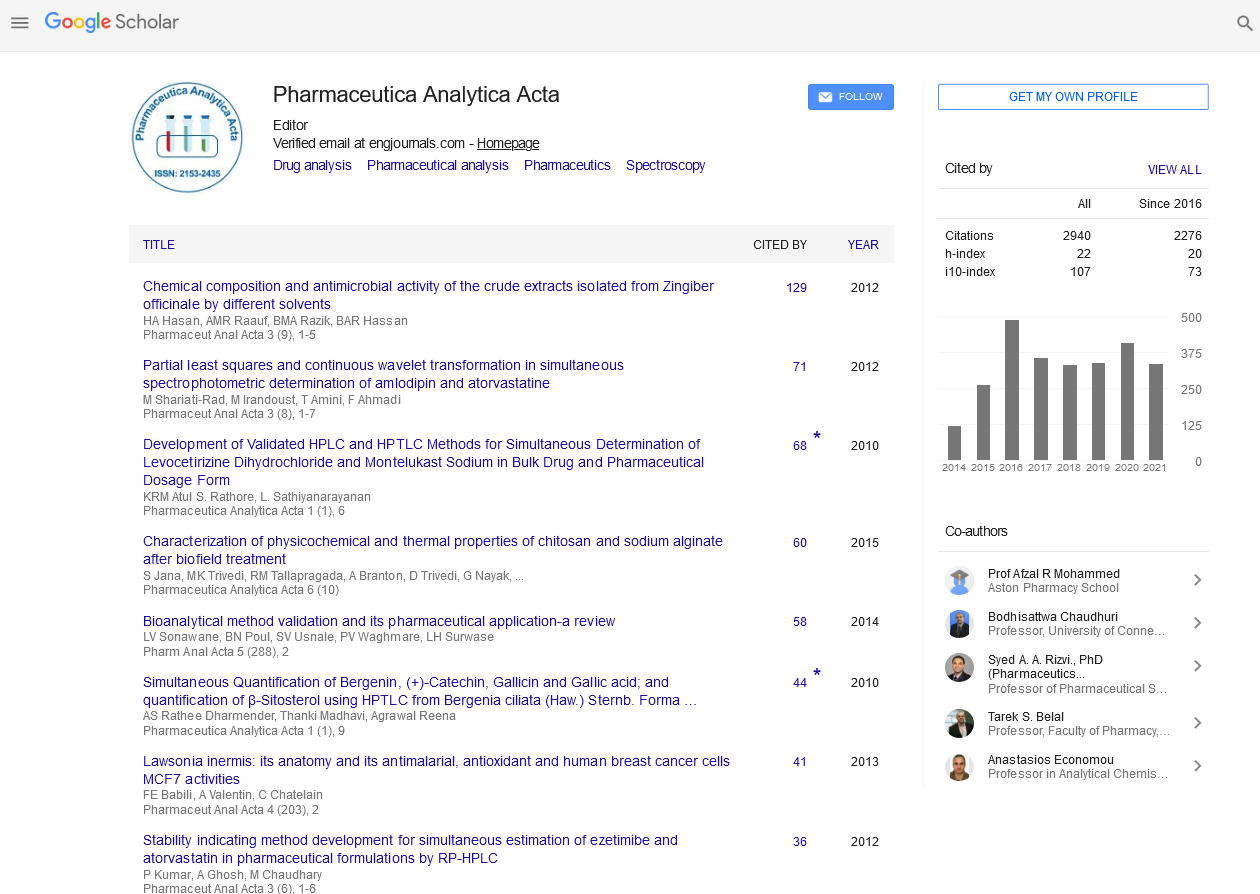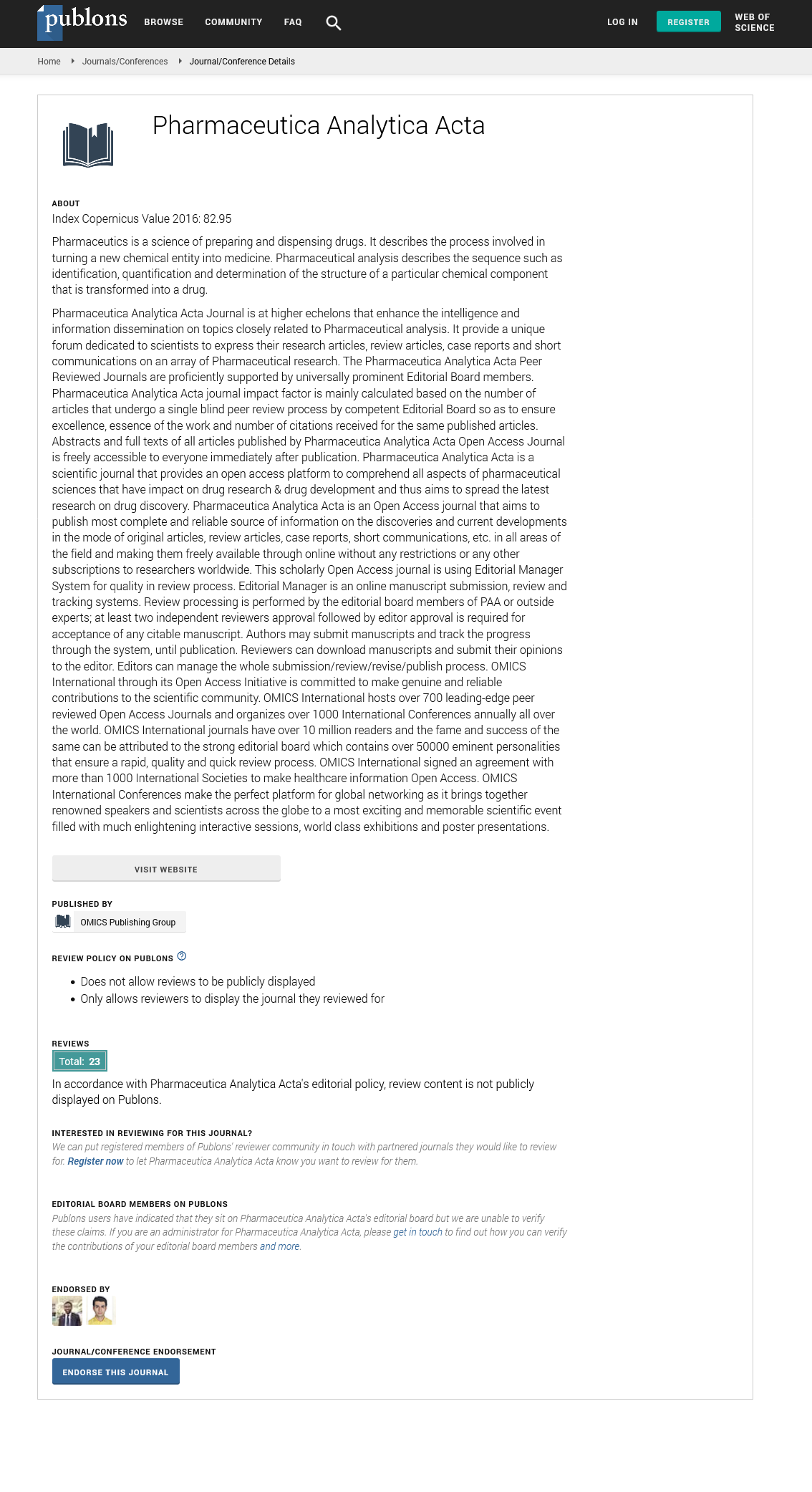Indexed In
- Open J Gate
- Genamics JournalSeek
- Academic Keys
- JournalTOCs
- The Global Impact Factor (GIF)
- China National Knowledge Infrastructure (CNKI)
- Ulrich's Periodicals Directory
- RefSeek
- Hamdard University
- EBSCO A-Z
- OCLC- WorldCat
- Publons
- Geneva Foundation for Medical Education and Research
- Euro Pub
- Google Scholar
Useful Links
Share This Page
Journal Flyer

Open Access Journals
- Agri and Aquaculture
- Biochemistry
- Bioinformatics & Systems Biology
- Business & Management
- Chemistry
- Clinical Sciences
- Engineering
- Food & Nutrition
- General Science
- Genetics & Molecular Biology
- Immunology & Microbiology
- Medical Sciences
- Neuroscience & Psychology
- Nursing & Health Care
- Pharmaceutical Sciences
Short Communication - (2025) Volume 16, Issue 3
Statistical Evaluation in Pharmaceutical Analytical Research
Sophie Nguyen*Received: 30-Aug-2025, Manuscript No. PAA-25-30234; Editor assigned: 01-Sep-2025, Pre QC No. PAA-25-30234; Reviewed: 16-Sep-2025, QC No. PAA-25-30234; Revised: 22-Sep-2025, Manuscript No. PAA-25-30234; Published: 30-Sep-2025, DOI: 10.35248/2153-2435.25.16.832
Description
The thoughtful application of statistical techniques allows scientists to distinguish genuine differences in experimental results from those that occur merely by chance. Sound statistical reasoning enhances the validity of experimental outcomes and strengthens confidence in the conclusions drawn from data. When statistical concepts are integrated into every phase study design, data collection and interpretation measurements become not only precise but also scientifically dependable. This approach is essential in disciplines that influence regulatory evaluation, manufacturing quality and clinical effectiveness.
Statistics provide a structured means to evaluate uncertainty, test hypotheses and verify that experimental procedures yield consistent and meaningful outcomes [1]. One of the most fundamental uses of statistical evaluation lies in determining precision and accuracy. Precision represents the degree of agreement among repeated measurements performed under identical conditions, while accuracy measures how close those results are to the true or expected value. Calculating parameters such as standard deviation coefficient of variation and confidence interval provides an objective measure of these qualities [2]. This assessment helps identify possible systematic errors or inconsistencies within a method. For instance, measuring a sample across multiple instruments might reveal slight deviations in readings. Statistical comparison determines whether these differences fall within acceptable limits or indicate procedural flaws that must be corrected. Without such analysis drawing conclusions solely from raw figures could result in misinterpretation or false confidence in results [3].
Regression analysis is another cornerstone of statistical interpretation enabling scientists to study relationships between an independent variable and its corresponding outcome. It is often employed to develop calibration curves that connect instrument signals with the concentration of a target compound. Reliable regression models confirm that this relationship remains linear across the required range, while correlation coefficients express the strength and reliability of that association. Deviations from linearity can signal instrument drift, sample contamination or inconsistencies in procedure. Through regression, scientists can diagnose and adjust for such issues, improving both the precision and dependability of reported data [4].
A complementary tool that allows researchers to determine whether observed variations among multiple groups are statistically meaningful or simply the result of random fluctuations. This technique is valuable in experiments comparing different batches, formulations or processing conditions. For example, when evaluating several production lots of a medicinal compound can reveal whether differences in concentration or potency are truly significant. This insight supports crucial decisions related to quality assurance, manufacturing optimization and product consistency. When combined with additional post hoc tests can pinpoint the specific conditions or groups responsible for observed discrepancies, deepening understanding and guiding necessary adjustments [5].
Another vital statistical approach is the Design of Experiments (DoE), which combines structured planning organized data collection and advanced analysis. Instead of examining one variable at a time DoE enables multiple factors to be studied simultaneously revealing not only individual effects but also interactions among them. This structured framework increases efficiency, reduces unnecessary testing and minimizes experimental error [6]. It helps scientists identify the key variables influencing outcomes, understand how these factors interact and optimize operational parameters for more reliable performance. Employing such a systematic statistical framework ensures that conclusions are supported by evidence rather than subjective interpretation or untested assumptions.
In method validation statistical evaluation plays a crucial role in establishing reliability and consistency. Validation processes often involve multiple operators, instruments or testing environments. Statistical comparison of these datasets offers objective proof that the method performs dependably under varying conditions. Metrics such as repeatability, intermediate precision and reproducibility are analyzed and compared against defined standards. Meeting these benchmarks confirms that a method can be applied confidently in production monitoring, compliance testing or clinical studies. In addition, statistical analysis allows comparisons between different experimental techniques helping identify the most effective and dependable approach for achieving consistent outcomes [7].
Beyond numerical assessment statistical reasoning also reinforces transparency and accountability. Accurate statistical reporting enables other scientists to independently verify the robustness of conclusions. Including information such as confidence intervals, limits of detection and measures of variability allows external reviewers to assess the strength of the findings. This level of openness minimizes the risk of bias, fosters reproducibility and ensures that discoveries can be validated across multiple settings [8].
By embedding statistical reasoning into the planning and interpretation of experiments, the resulting data become not just measurements but meaningful evidence that can inform decision-making and promote scientific integrity. Moreover, the thoughtful use of statistics transforms experimental work from observation to understanding. It allows investigators to interpret complex datasets, identify hidden relationships and make informed predictions [9]. This capability supports innovation, reliability and continual improvement within technical and industrial applications. Statistical literacy also empowers professionals to critically evaluate the quality of external findings ensuring that decisions are based on verified and reproducible evidence rather than assumptions or incomplete analysis. In summary, statistical evaluation is fundamental to the credibility and reliability of scientific data. Techniques such as regression analysis, variance testing and experimental design enable the measurement of precision assessment of accuracy and determination of significant differences within results [10].
References
- H. Brooks W, C. Guida W, G. Daniel K. The significance of chirality in drug design and development. Curr Top Med Chem. 2011;11(7):760-770.
[Crossref] [Google Scholar] [PubMed].
- Yu RB, Quirino JP. Chiral selectors in capillary electrophoresis: Trends during 2017-2018. Molecules. 2019 Mar 21;24(6):1135.
[Crossref] [Google Scholar] [PubMed].
- Saz JM, Marina ML. Recent advances on the use of cyclodextrins in the chiral analysis of drugs by capillary electrophoresis. J Chromatogr A. 2016;1467:79-94.
[Crossref] [Google Scholar] [PubMed].
- Vogt FG, Kord AS. Development of quality-by-design analytical methods. J Pharm Sci. 2011;100(3):797-812.
[Crossref] [Google Scholar] [PubMed].
- Monks K, Molnár I, Rieger HJ, Bogáti B, Szabó E. Quality by design: Multidimensional exploration of the design space in high performance liquid chromatography method development for better robustness before validation. J Chromatogr A. 2012;1232:218-230.
[Crossref] [Google Scholar] [PubMed].
- Orlandini S, Pinzauti S, Furlanetto S. Application of quality by design to the development of analytical separation methods. Anal Bioanal Chem. 2013;405(2):443-450.
[Crossref] [Google Scholar] [PubMed].
- Parr MK, Schmidt AH. Life cycle management of analytical methods. J Pharm Biomed Anal. 2018;147:506-17.
[Crossref] [Google Scholar] [PubMed].
- Chankvetadze B. Contemporary theory of enantioseparations in capillary electrophoresis. J Chromatogr A. 2018;1567:2-5.
[Crossref] [Google Scholar] [PubMed].
- FejÅ?s I, Kalydi E, Malanga M, Benkovics G, Béni S. Single isomer cyclodextrins as chiral selectors in capillary electrophoresis. J Chromatogr A. 2020;1627:461375.
[Crossref] [Google Scholar] [PubMed].
- Qi L, Qiao J. Progress of chiral ligand-exchange capillary electrophoresis for enantioseparation. J Chromatogr A. 2022;1679:463381.
[Crossref] [Google Scholar] [PubMed].
Citation: Nguyen S (2025). Statistical Evaluation in Pharmaceutical Analytical Research. Pharm Anal Acta. 16:832
Copyright: © 2025 Nguyen S. This is an open-access article distributed under the terms of the Creative Commons Attribution License, which permits unrestricted use, distribution and reproduction in any medium, provided the original author and source are credited.


